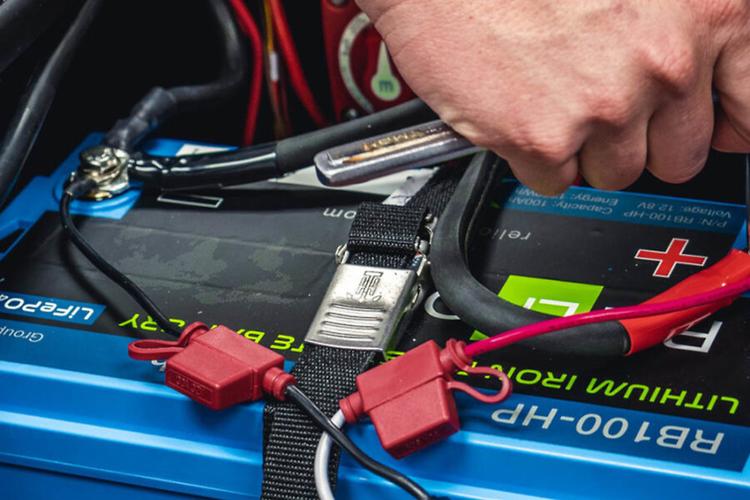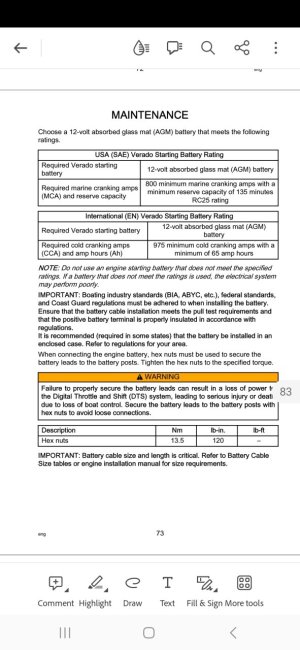You are using an out of date browser. It may not display this or other websites correctly.
You should upgrade or use an alternative browser.
You should upgrade or use an alternative browser.
Wiring/Charging Question
- Thread starter Skins88
- Start date
BC Coast Pilot
Well-Known Member
I have an ACR on each engine as I troll with 1 main. And isolated battery switches port and stbd. So effectively each engine will charge the house and then spill to the other engine when running on 1. Works well for me, could it be better?I'll ask again. I thought he said two acr's... I'm a dumb plumber. This reminds me of when my elec and controls subs at work start arguing about who wires what and expect me to tell them what to do. Lol.
ship happens
Well-Known Member
The answer is yes. We came up with a solution I dunno about 2016ish I don't know. Consists of the 5511E switch and the 6011 switch. When wired with 3 banks, 3 engines with one circuit breaker and one ACR, it does all you need it to do to manage 3 engines with 3 banks safely and cost effectively with the ease of use from 2 switches. I'm not going to draw it. However I will answer questionsI have an ACR on each engine as I troll with 1 main. And isolated battery switches port and stbd. So effectively each engine will charge the house and then spill to the other engine when running on 1. Works well for me, could it be better?
BC Coast Pilot
Well-Known Member
Ha, right now I'm like.....If it ain't brokeThe answer is yes. We came up with a solution I dunno about 2016ish I don't know. Consists of the 5511E switch and the 6011 switch. When wired with 3 banks, 3 engines with one circuit breaker and one ACR, it does all you need it to do to manage 3 engines with 3 banks safely and cost effectively with the ease of use from 2 switches. I'm not going to draw it. However I will answer questions
ship happens
Well-Known Member
Yeah fair enough. However if your going to do it, do it right. Make it easyHa, right now I'm like.....If it ain't broke
Jegermiester
Member
Found this wiring diagram on the Blue Sea Systems site for a 2 battery bank system:The answer is yes. We came up with a solution I dunno about 2016ish I don't know. Consists of the 5511E switch and the 6011 switch. When wired with 3 banks, 3 engines with one circuit breaker and one ACR, it does all you need it to do to manage 3 engines with 3 banks safely and cost effectively with the ease of use from 2 switches. I'm not going to draw it. However I will answer questions
ship happens
Well-Known Member
That is the switch. The diagrams will get you there eventually. If you put the boots to the drawing board. They don't have the drawing however.Found this wiring diagram on the Blue Sea Systems site for a 2 battery bank system:
zurk
Well-Known Member
bms will cut out. battery is fully sealed.I'm curious to know what happens when the boat becomes a bit submerged, or the battery compartment floods. Will the boat catch fire? so now not only are you sinking but also on fire. Neither are a great situation but compounded would certainly get your attention. That and I would have to buy a new inverter charger is my limiting factor for switching the house system over.
zurk
Well-Known Member
thats a bit different than claiming its a govt reg. the reason you did it is to reduce stress on the starter lead acids which get stressed when cranking the starter due to the fact they arent deep cycle. that no longer applies with lithium systems.I don't know where to find it. Its how we setup boats. I deal with surveyers all the time. As a boat builder and a mechanic there is reasons we do things a certain way. One engine one battery, and whatever type battery required for that engine is used. Period the end.
absolutely nothing to do with redundancy since you have a common negative anyway.
anyhow in 10 years i bet ACRs and lead acid will go the way of the dodo. new boats will all have single lithium house/starter battery setups. if you can eliminate 100kg of weight, 30-40 hours of skilled labor to install wiring/battery boxes/ACRs etc and reduce your BOM cost by a few dozen ACRs/relays and fuses you bet manufacturers are going to jump on it like hot potatoes, especially for complicated multi engine setups. you heard it here first. also helps that ABYC is now issuing guidance approving lithium systems on boats AND insurers dont care anymore if you have a lithium setup.
Last edited:
BC Coast Pilot
Well-Known Member
zurk
Well-Known Member
thats a suggestion to use AGMs not a mandate. eventually that guidance will change as lithium becomes more common.
anyway the lithiums have 1000CCA so they exceed the technical spec required in the manual even if they are not AGM. and they have around 860% more amp hours than are required.
anyway the lithiums have 1000CCA so they exceed the technical spec required in the manual even if they are not AGM. and they have around 860% more amp hours than are required.
BC Coast Pilot
Well-Known Member
Interesting opinion, so if you burn up the engine harness or have an electrolysis issues or some other item that would/should be a warranty item how do you think Mercury would proceed with engine replacement if you were using lithiums? When it clearly states AGM spec in the installation manual. Don't get me wrong here, I'd love to shed 600lbs but at the risk of what? It's only prudent to have the questions answered.thats a suggestion to use AGMs not a mandate. eventually that guidance will change as lithium becomes more common.
anyway the lithiums have 1000CCA so they exceed the technical spec required in the manual even if they are not AGM. and they have around 860% more amp hours than are required.
Last edited:
Damn Ugly
Well-Known Member
Interesting opinion, so if you burn up the engine harness or have an electrolysis issues or some other item that would/should be a warranty item how do you think Mercury would proceed with engine replacement if you were using lithiums? When it clearly states AGM spec in the installation manual. Don't get me wrong here, I'd love to shed 600lbs but at the risk of what? It's only prudent to have the questions answered.
I was told by Bridgeview to only use lead-acid or AGM directly connected to the my new Mercs or run the risk of burning out the alternator or destroying the lithium battery. If you Google "will my alternator charge a lithium battery", the articles are pretty clear about the problems around cut-in and cut-out voltages, as well as "Constant Voltage" versus "Constant Current" and the different requirements of acid vs. lithium.
BC Coast Pilot
Well-Known Member
Similar to what the Mercury Master Mechanic Tech has advised me. He leaned towards the AGM due to the voltage requirements.I was told by Bridgeview to only use lead-acid or AGM directly connected to the my new Mercs or run the risk of burning out the alternator or destroying the lithium battery. If you Google "will my alternator charge a lithium battery", the articles are pretty clear about the problems around cut-in and cut-out voltages, as well as "Constant Voltage" versus "Constant Current" and the different requirements of acid vs. lithium.
Last edited:
zurk
Well-Known Member
unless it was directly caused by the lithiums mercury wouldnt care. same as if you replaced the lead acid in your car with AGM or repainted the car or something it should not affect your engine warranty. i took my yammy in for warranty service connected to a dakota lithium and the mechanics didnt have any issues with it.Interesting opinion, so if you burn up the engine harness or have an electrolysis issues or some other item that would/should be a warranty item how do you think Mercury would proceed with engine replacement if you were using lithiums? When it clearly states AGM spec in the installation manual. Don't get me wrong here, I'd love to shed 600lbs but at the risk of what? It's only prudent to have the questions answered.
usually you wire in a sterling APD to prevent the alternator burn out which is a real thing - the alternators burn out if the BMS shuts off for any reason - https://www.sterling-power-usa.com/SterlingPower12voltalternatorprotectiondevice.aspx the APD kicks in and allows the alternators time to shut off charging on loss of lithium connection. you basically plug the APD into your alternator and then plug the alternator into the lithium battery. its basically a cheap tiny inline resistor.
as far as voltage goes the existing alternators will only charge the lithium to 80% but that is what you want anyway for long life.
ironically i no longer own a single boat with lead acid or AGM. my kingfisher has a 12v dakota lifepo4, my electric jet kayak has a 24v dakota lifepo4, my yacht has 5 12v roamer lifepo4s, my ab rib has a 24v roamer lifepo4. so no more lead for me.
Last edited:
BC Coast Pilot
Well-Known Member
It doesn't work on an opinion, It needs to be in writing from the manufacturer.
zurk
Well-Known Member
It doesn't work on an opinion, It needs to be in writing from the manufacturer.

Mercury approves lithium-ion cranking batteries for all current outboard engines
Been frustrated because you can’t use lithium-ion as a cranking battery for your Merc? Now you can
ironically relions are really sh*tty lifepo4s so i would advise ignoring the mercury manufacturer recommendation. haha.
Mercury Updated Lithium Service Bulletin 9/26/22 - Page 2
As of 9/26/2022, Mercury has issued Service Bulletin 2022-19 stating that the listed engines will be permitted to use a Lithium Iron Phosphate Battery that is designed for engine cranking, as long as it meets the listed specifications:
-2.1L 75-115hp Fourstroke, ProXS and SeaPro Models
-3.0L 150hp Fourstroke, ProXS and SeaPro
-4.6L V8 and 3.4L V6 175-300hp Fourstroke, ProXS, SeaPro and Verado Models
-2.6L L6 200-400 Pro and Verado Models
-7.6L V12 500-600hp SeaPro and Verado Models.
-NO other engines approved at this time.
Minimum Specs Required:
-Chemistry/Format: Lithium IRON Phosphate designed for MARINE CRANKING USE.
-Minimum Cranking Amps: 800A for 8 second minimum @ 20 Degrees F
-Peak Charge Acceptance: 165A at 20-130 degrees F for one minute
-Max Charge Alternator Size: 150A at 20-130 degrees F
-Max Charge Voltage/Alternator Output: 14.8V
-Reserve Capacity (RC25 @ 80F): 135 Minutes
-Ingress Protection (IP rating): IP67 or greater.
Cautions that use at temperatures below 32F may require additional equipment such as a battery heater.
Bulletin also lists a Relion Battery that has been evaluated and meets the above requirements: RB100-HP.
Last edited:
Similar threads
- Replies
- 0
- Views
- 308
- Replies
- 21
- Views
- 4K
- Replies
- 0
- Views
- 315


